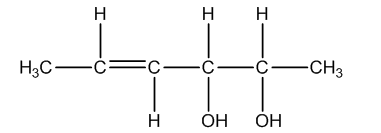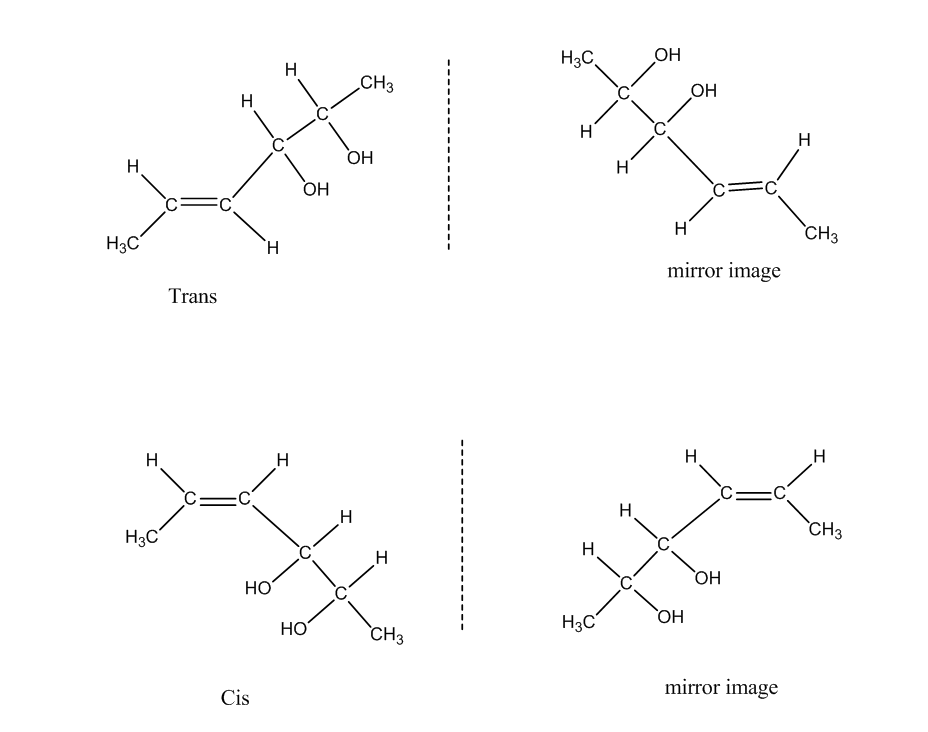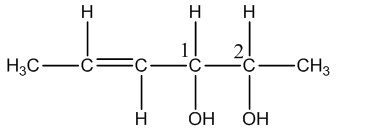
The total number of configurational isomers of the given compound are:

A. 2
B. 4
C. 6
D. 8
Answer
122.4k+ views
Hint: Configurational isomers are the stereoisomers that cannot be converted into one another by rotation around a single bond in the molecule. There are two types of Configurational isomers. 1) Geometrical isomers and 2) optical isomers.
Complete step by step solution:



Total number of configurational isomers = geometrical isomers + optical isomers.
So, totally 8 configurational isomers are going to form by the given compound.
So, the correct option is D.
Note: Don’t be confused between geometrical isomerism and optical isomerism. The compounds that have double bonds will show geometrical isomerism and the compounds which have chiral centers show the optical isomerism. Both the isomerisms combined are called geometrical isomerism.
Complete step by step solution:
Geometrical isomerism is going to show by unsaturated compounds and optical isomerism is going to exhibit by the molecules that are having chiral carbons.
The given molecule contains six carbons, one double bond and two chiral centers.

Now we will talk about geometrical isomerism.
The following are the geometrical isomers of the given compound.

Now there are two forms called Trans and Cis they have mirror images also. So, the geometrical isomers formed are four.
Coming to optical isomers, the given compound has two chiral centers and shown in the below image.

The numbers 1 and 2 represent two chiral centers.
There is a formula to calculate the number of isomers from chiral centers.
Optical isomers = \[{{2}^{n}}\], here n = number of chiral centers.
We know that in the given compound there are two chiral centers.
Therefore the number of optical isomers = \[{{2}^{2}}=4\].
Total number of configurational isomers = geometrical isomers + optical isomers.
= 4 +4
= 8.
So, totally 8 configurational isomers are going to form by the given compound.
So, the correct option is D.
Note: Don’t be confused between geometrical isomerism and optical isomerism. The compounds that have double bonds will show geometrical isomerism and the compounds which have chiral centers show the optical isomerism. Both the isomerisms combined are called geometrical isomerism.
Recently Updated Pages
NIT Andhra Pradesh Cutoff 2025: Check JEE Main Round Wise Cutoff Ranks

JEE Main Cut-Off for MNIT Jaipur 2025: Round-Wise Ranks & Trends

How to find Oxidation Number - Important Concepts for JEE

A Single Concept to Explain Everything in Ray Optics Plane Mirrors

How Electromagnetic Waves are Formed - Important Concepts for JEE

Bohr’s Theory of Hydrogen Atoms – Important Formulas

Trending doubts
JEE Mains 2025: Check Important Dates, Syllabus, Exam Pattern, Fee and Updates

JEE Main Login 2045: Step-by-Step Instructions and Details

JEE Main Chemistry Question Paper with Answer Keys and Solutions

JEE Main Exam Marking Scheme: Detailed Breakdown of Marks and Negative Marking

JEE Main 2025 Physics Dimensions of Magnetic Field Induction Formula and Derivation

JEE Main 2023 January 24 Shift 2 Question Paper with Answer Keys & Solutions

Other Pages
NCERT Solutions for Class 12 Hindi Aroh Chapter 1 Aatmaparichay, Ek Geet

NCERT Solutions for Class 12 Chemistry Chapter 6 Haloalkanes and Haloarenes

NCERT Solutions for Class 12 Chemistry Chapter 1 Solutions

NCERT Solutions for Class 12 Chemistry Chapter 2 Electrochemistry

JEE Advanced Marks vs Ranks 2025: Understanding Category-wise Qualifying Marks and Previous Year Cut-offs

NCERT Solutions for Class 12 Chemistry Chapter 7 Alcohol Phenol and Ether




